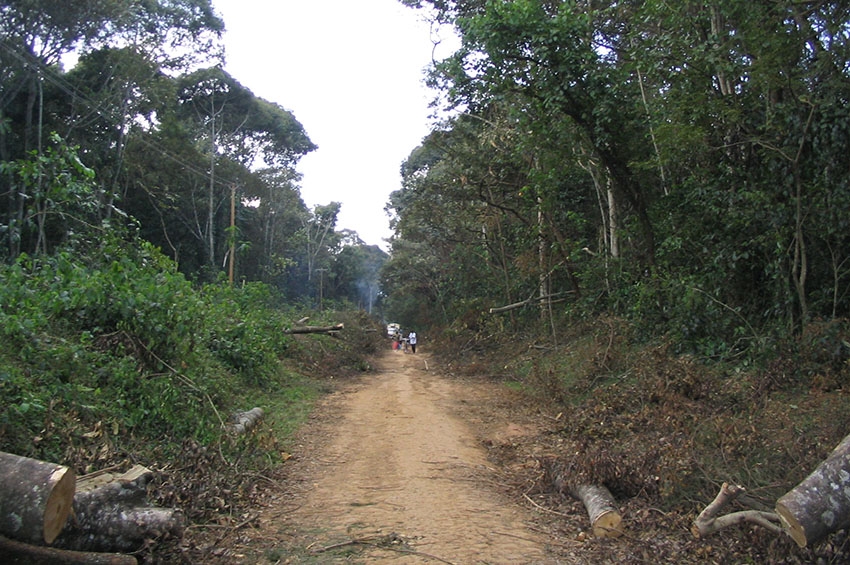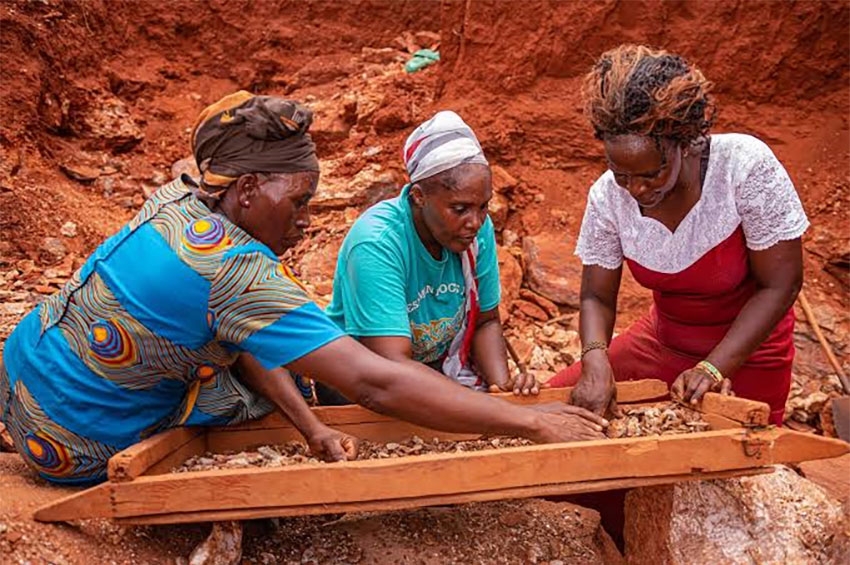Kakamega forest is recognized as the eastern-most relic of the Guineo-Congolian lowland rainforest belt, which once stretched from Kenya across Uganda, East and Central Africa to the West African coast. Situated in Western Kenya, 35 km from Lake Victoria, Kakamega Forest is an exclusive sanctuary for an extraordinary variety of endemic flora and fauna, including insects, reptiles and birds which are not found in other parts of Kenya. An estimated 10 - 20% of the animal species in the forest are unique to this forest. It is also an important watershed for some of the rivers that flow into Lake Victoria. The forest is invaluable to the people living around it, as a source of income and subsistence through products such as timber, fuelwood, herbal medicines, pasture, building materials and food. However, much of the outer part appears to have been a mosaic of woodland, grassland and forest patches.
The forest covers about 230 km2, and less than half of this area currently remains as indigenous forest. There are numerous grassy clearings and glades. Large mammals are rare in the forest, but the extensive variety of birds, reptiles and insects make it a specialist eco-tourism attraction for bird watchers and wildlife photographers. Part of the forest also contains unique and rich highland ecosystems, but generally the fauna and flora of the Forest have not been studied comprehensively. The forest experiences a very wet climate, with over two meters of rain annually. The rainy seasons are April-to-May and August to September.
Geographical extent of Kakamega Forest Ecosystem
Kakamega Forest Ecosystem Exceptional Resource Values
KFE Exceptional Resource Values describe the area’s key natural resources and other features that provide outstanding benefits to local, national and international stakeholders and that are especially important for maintaining the area’s unique qualities, characteristics and ecology. The following sections describe the KFE ERVs: vegetation and plant communities, insect diversity, primate diversity and local (Luhya) culture.
- Biodiversity values
Diversity of primates
Kakamega forest is the habitat to five out of the eight primate species found in Kenya. Monkeys are the most conspicuous group of mammals in the forest, with the Blue Monkey (Cercopithecus mitis stuhlmanni), the Redtail Monkey (Cercopithecus ascanius schmidti), and the Black-and-White Colobus Monkey (Colobus guereza) as the most common species. Aside from their important role in the ecosystem as seed dispersers, they have significant ecotourism value, since they are well habituated in some areas, especially Isecheno, as a result of long-term scientific studies.
Despite the prevalence of the Pottos (Perodicticus potto ibeanus) in the forest they are nocturnal and much harder to detect. In contrast, baboons (Papio cynocephalus anubis) are well known as pests in the lands adjacent to the forest, particularly in the north of the forest and Kisere Forest. The De Brazza’s Monkey (Cercopithecus neglectus) is rare in Kenya and is confined to the riverine vegetation of Kisere Forest. However, this small population of about 25-50 animals, appears to be one of the largest in the country.
High insect diversity
KFE is endowed with a high diversity of insects. Butterflies are represented by 487 species which constitute 54% of the 900 species known to Kenya. Moths are also common species in this area, with recorded totals of 53 Hawk moths (Sphingidae), 37 Emperor Moths (Saturniidae), and 43 Tiger Moth species (Arctiinae).
A total of 72 dragonfly species, representing 42% of Kenya’s dragonfly fauna, has been recorded in the Kakamega forest. Twenty species are of national importance in Kenya, since they are only found at this site within the country. At the global level, Onychogomphus styx and Chlorocnemis pauli are classified as ‘Near Threatened’, although most species are listed as ‘Least Concern’. As terrestrial and aquatic top predators, dragonflies play an essential role in food webs and consequently they are beneficial to the entire ecosystem. The species found only in Kakamega are particularly considered to be good indicators of habitat quality.
Kakamega forest has also recorded a total of 170 ant species, with estimated species numbers lying between 200 and 250. Several ant species which have been described as new to science were first collected in Kakamega Forest, particularly those in the genus Axinidris. It is very likely that Kakamega Forest holds more species than any other locality in Kenya and nationally the ant fauna of this forest is unique as most of the dominating species in the forest are of Guineo-Congolian origin.
Termites are among the most important groups of invertebrate decomposers and have enormous impact on soil properties and nutrient cycling. However, most termite taxa are poorly understood and the relationship between termite diversity and ecosystem services is not well known. Research suggests that, of the 62-termite species described in Kenya, 25 species have so far been found in Kakamega Forest.
To date there are 243 species of bees found in Kakamega Forest. Pollinators exert direct effects on plant demography, population genetics, and plant community composition, and they influence indirect effects on all higher trophic level organisms that exploit plants for food or shelter.
Rich diversity of vegetation and plant communities
The uniqueness of the Kakamega Forest lies in its rich diversity in plant species, which are not found elsewhere in Kenya. It is home to the Elgon teak and Prunus africana, which are species of special conservation concern (locally threatened and rare). These species are prone to over exploitation due to their high-quality timber and medicinal value. In addition, scientific research has indicated the presence of 13 different plant communities, each representing a different succession stage. A large area of Kakamega Forest consists of middle-aged secondary forest but much of the Buyangu area and the north-eastern part of the forest are characterised by very young secondary forest.
Natural Glades
There are several natural glades within KFE that provide a brilliant and interesting contrast to the forest. The glades are usually comprised of small trees; Combretum molle, Psidium guajava, Maesa lanceolata, Harungana madagascariensis and Chaetacme aristata. They range in size from approximately 1 to 50 ha, with a having few larger clearings. The origins of the glades are uncertain though some are certainly recent clearings, while others pre-date recent records. These may have originated from past human activity such as cattle grazing or may be the result of herbivory and movements by large mammals such as buffaloes and elephants (both are currently extirpated from the region).
The Luhya Culture
The involvement of the local community in the KFE tourism initiatives is therefore encouraged whenever possible, as this has the potential to increase direct benefits to KFE adjacent communities. The KFE adjacent community has a rich cultural heritage which has recently received substantial publicity in the local and international media. The Luhya are nationally renowned for their energetic and vibrant isukuti dance, a celebratory performance involving rapid squatting and rising, accompanied by thunderous and rhythmic drumbeats. Moreover, traditional bullfighting is still considered a sport among sections of the Luhya community. The annual bullfighting and cock fighting competitions attracts many spectators. Further, the Luhya cuisine mainly comprised of chicken, which is at times boiled using traditional herbs, usually attracts thousands of visitors to the region. Further, the people of Ilesi and Mukhonje maintain their livelihoods through pottery till present day. Lubao town hosts dog sellers every week, making it a unique market in the region.
There is need to nurture this rich culture through establishment of cultural centres and gazettement of some of the unique features and events of the Luhya community. In addition, the forest acts as a significant location for traditional ceremonies and worship. There are sacred sites within the forest which include: Ikavakava shrine, used for cleansing community offenders by selected traditional healers and Tiriki sacred forests, which are forest patches mainly used as circumcision sites by the Tiriki sub-tribe of the Luhya community.
In order to obtain maximum benefits from the opportunities offered by the cultural experience, measures that take into consideration the interests of visitors as well as the respect for the Luhya culture should be adopted. The community should be encouraged to construct cultural centres in various regions of the ecosystem. The moment these centres are established, a KFE Cultural Centre Association consisting of representatives from the existing cultural centres will should be set up in order to brand and set operational standards for the cultural centres, as well as liaise with tour operators and other stakeholders regarding pertinent matters on these centres.
In KFE, some community members have formed organized groups to practice ecotourism as an economic venture. There is however high potential for communities to participate in tourism activities ranging from: establishing tourism accommodation facilities, offering guided walks, establishing cultural centres and curio shops, offering various aspects of culture (traditional rituals, ceremonies, medicinal plants, etc) as tourism products, offering home stays, and volunteer tourism. As such, organizing seminars/workshops on annual basis and invite speakers to educate the groups on different aspects of establishing and running tourism enterprises.
Human Wildlife Conflicts hotspots in the KFE include farmlands adjacent to Malava forest where baboons are the main problem animals, and Buyangu, Kisere and Kibiri forest adjacent areas where monkeys are the problem animals. A wide variety of problem animal control indigenous techniques have been developed and tested. Use of Osimum spp., as a buffer separating the forest and farmlands, for example, has been tried at Ikuywa within KFE and has been effective in preventing crop raiding by primates. Apart from providing a buffer, Osimum is a commercial plant that is used in the manufacture of ointment. Hence, to minimize conflicts, efforts will be made to promote its use as a buffer in other areas of KFE. In addition, other plant species that keep out primates such as Kei-apple and Mauritius thorn will also be promoted. All these activities will be geared towards empowering the communities to participate in tourism development for livelihood improvement.
















